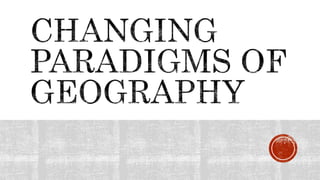Explain the paradigm changes in Geography
Paradigm is just a way of your interpretation that how you interpret something. And geographic paradigms have changed time by time. In previous time we think of a one continent Pangea but now we are familiar with several.It passed from the descriptive and teleological phase to the quantitative, radical and dialectical materialism stage. Various methodologies have been adopted to give precise and reliable description of places in literary as well as mathematical languages.
All the empirical laws, formulated mainly in the social sciences, are valid for a specific place and specific time and are therefore termed as models, structured ideas of paradigms.If we begin with the period of Carl Ritter who is considered as one of the founders of modern geographical thought.Being a teleologist, Ritter asserted that all phenomena are spatially distributed according to the plan of God for mankind.
The post-Ritter period was dominated by Darwin who revolutionized the entire philosophy of science and brought a cause and effect approach in explaining spatial distribution of phenomena. It was during this period that geographers and scientists started thinking seriously about the nature of geography, and concentrated on the issue, whether geography can be regarded as a science.
After Darwin, scientists were looking for the controlling laws of nature (and the materially conditioned social laws) and to a considerable extent adopted a nomethetic (general law-making) approach. At this stage, inductive arguments were increasingly replaced by hypothetic deductive methods.
These were used to postulate a set of hypotheses which could be confirmed, corroborated or rejected by testing empirical data through experiment. The theories postulated about the evolution of landforms, normal cycle of erosion, etc. The heartland theory by William Morris Davis and Mackinder fell under this category of geographical models.
At this stage, Vidal de Lablache and his followers laid stress on possibilism and declared that man is not a passive agent ruled by the forces of nature which play their role and determine man’s destiny and shape human society.
Although possibilism and regional geographical school developed new paradigms and became very popular, these could not remove the deterministic model in toto. Thus, the deterministic explanatory model survived side by side with possibilism. Kuhn has termed this period as ‘revolutionary phase’.
After the Vidalian tradition, the major concern of geographers became to study regions.
Regional geography flourished in France and got diffused in the neighbouring countries. But, later on, this approach also became inadequate to explain the regional personality, and therefore, a period of crisis in the discipline emerged. It brought about quantitative revolution and functional approach in geography. Now geographers began using more models, especially in the field of human geography.
The concept of paradigm was propounded by Kuhn.
The concept of Paradigm by Kuhn: Thomas Kuhn wrote, “The Structure of Scientific Revolution” (1962). Kuhn fathered, defined, and popularized the concept of “paradigm shift”. It is a fundamental change in the basic concepts and experimental practices of a scientific discipline. Thomas Kuhn argued that science does not evolve gradually towards truth. Science has a paradigm that remains constant before going through a paradigm shift when current theories can’t explain some phenomenon, and someone proposes a new theory. A scientific revolution occurs when: the new paradigm better explains the observations, and offers a model that is closer to the objective, external reality; and the new paradigm is incommensurate with the old. For example, Lamarckian evolution was replaced with Darwin’s theory of evolution by natural selection.
BOOK NOTES CLICK HERE












1 Comments
Good
ReplyDelete